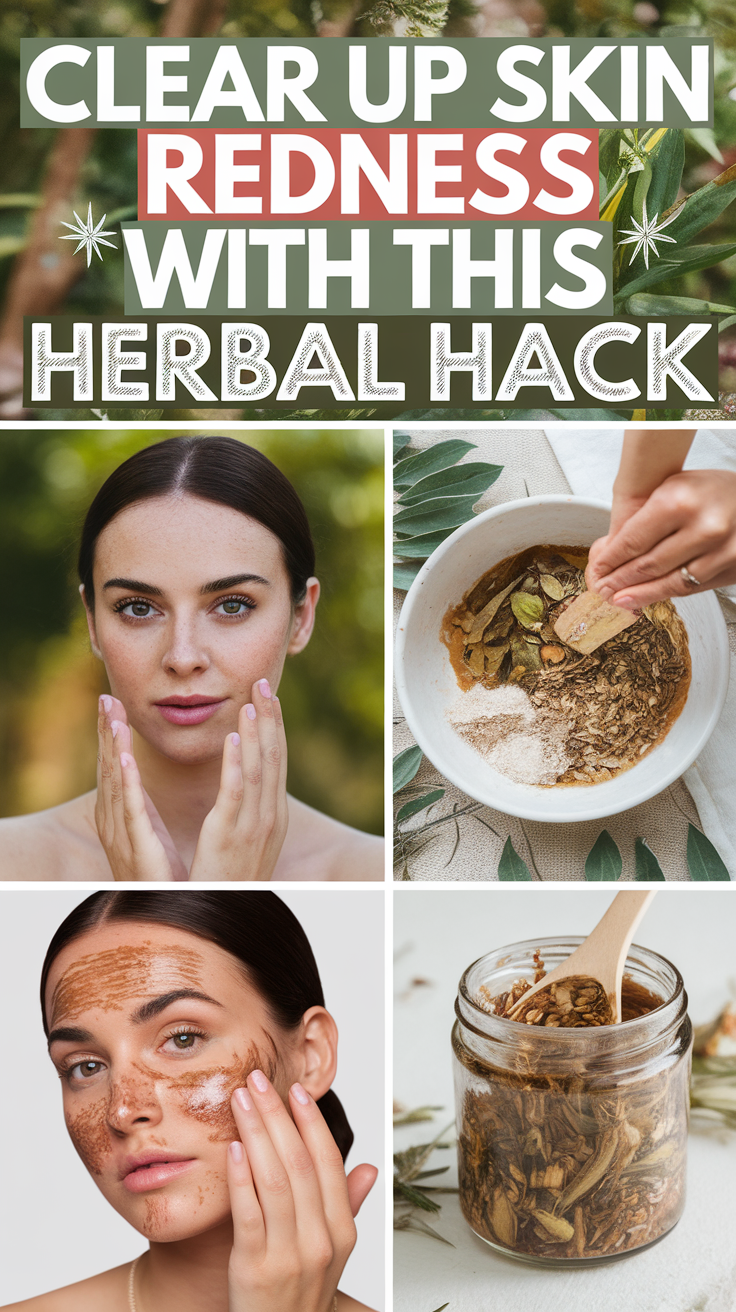Clear up Skin Redness With This Herbal Hack
To clear up skin redness, try herbal remedies like chamomile and aloe vera. Both have anti-inflammatory properties that soothe irritation and promote healing. You can prepare a simple infusion by steeping the herbs in hot water, then applying the cooled mixture to affected areas. Remember to stay hydrated and use gentle cleansing techniques to enhance results. If redness persists or worsens, further insights into personalized approaches can help you achieve the clarity you’re looking for.
Key Takeaways
- Use chamomile tea as a soothing compress to reduce inflammation and redness on irritated skin.
- Apply aloe vera gel directly to affected areas for its hydrating and anti-inflammatory benefits.
- Create a calendula infusion and apply it topically to promote healing and decrease skin redness.
- Incorporate green tea into your skincare routine for its antioxidant properties that protect and soothe the skin.
- Conduct a patch test with herbal remedies to ensure no allergic reactions occur before widespread use.
Understanding Skin Redness
What causes skin redness? This phenomenon often stems from increased blood flow to the skin’s surface, which can result from various factors.
When your body experiences irritation, infection, or an allergic reaction, inflammation occurs, manifesting as redness. Conditions like eczema or rosacea can exacerbate this response, causing your skin to appear flushed and sensitive. Additionally, factors such as antioxidant properties found in natural remedies can help combat inflammation and promote healing.
To manage skin redness effectively, you might consider a skin inflammation remedy that addresses the underlying cause rather than just masking the symptoms. Natural options, such as aloe vera or chamomile, can provide soothing benefits. Essential oils can also be beneficial in promoting skin healing and reducing inflammation.
Understanding your skin’s reactions will help you choose the right treatments and maintain a healthier complexion, minimizing the frequency and severity of redness episodes.
Common Causes of Skin Redness
Several factors can lead to skin redness, each with distinct underlying mechanisms.
Allergic reactions, such as contact dermatitis, occur when your skin reacts to irritants or allergens, causing inflammation.
Infections, including bacterial or viral, can also trigger redness as your immune system responds to pathogens.
Conditions like rosacea result in chronic redness due to vascular instability and inflammation.
Environmental factors, such as extreme temperatures or sun exposure, can dilate blood vessels, leading to transient redness.
Additionally, lifestyle choices like alcohol consumption and spicy foods can exacerbate the condition.
Understanding these causes helps you identify triggers and seek appropriate treatment, ensuring your skin remains healthy and radiant.
Benefits of Herbal Remedies
Herbal remedies offer significant benefits for reducing skin redness due to their natural anti-inflammatory properties. By incorporating these remedies, you can also enhance skin nourishment and hydration, promoting overall skin health. Understanding these advantages can help you make informed choices for managing your skin concerns effectively. Additionally, many herbal remedies, such as tea tree oil, have been shown to possess powerful antimicrobial properties that can aid in treating skin infections. Furthermore, certain herbal treatments can also provide effective antifungal treatments that are essential for addressing underlying fungal issues contributing to skin redness.
Natural Anti-Inflammatory Properties
Natural remedies offer a range of anti-inflammatory properties that can greatly benefit those struggling with skin redness.
Herbs like chamomile and calendula contain compounds such as flavonoids and essential oils that help reduce inflammation and soothe irritated skin. These natural ingredients work by inhibiting the release of inflammatory mediators, effectively calming redness and irritation.
Additionally, green tea, rich in polyphenols, provides antioxidant protection, further reducing inflammation. Incorporating these herbal remedies into your skincare routine can lead to noticeable improvements in skin clarity and comfort.
Skin Nourishment and Hydration
While you may often focus on treating skin redness, nourishing and hydrating your skin is equally essential for maintaining its overall health.
Herbal remedies provide a wealth of benefits that can elevate your skincare routine. Here are four key advantages:
-
Enhanced Moisture Retention: Natural oils, like jojoba and avocado, form a protective barrier that locks in hydration.
-
Rich Nutrient Profile: Herbs such as chamomile and calendula are packed with vitamins and antioxidants that promote skin health.
-
Improved Skin Barrier Function: Regular use of herbal infusions can strengthen your skin’s natural defenses against environmental stressors.
-
Reduced Inflammation: Ingredients like aloe vera and green tea help soothe and calm irritated skin, contributing to a more balanced complexion.
Incorporating these remedies can greatly improve your skin’s health and appearance.
Key Herbs for Reducing Redness
Certain herbs possess anti-inflammatory properties that can effectively reduce skin redness.
Chamomile, known for its soothing effects, contains antioxidants that calm irritated skin.
Aloe vera is another excellent choice, as its gel-like substance hydrates while reducing inflammation.
Calendula, with its anti-inflammatory compounds, promotes skin healing and reduces redness.
Green tea is rich in polyphenols, which help diminish redness and protect skin from environmental stressors.
Additionally, licorice root contains glabridin, which can inhibit the inflammatory response and lighten redness.
Incorporating these herbs into your skincare routine can provide a natural, effective approach to managing skin redness, promoting a more even complexion.
Always consult a healthcare professional before starting new herbal remedies to verify they suit your skin type.
Preparing Your Herbal Remedy
After exploring the key herbs beneficial for reducing skin redness, it’s important to understand how to prepare these herbal remedies effectively.
Follow these steps to guarantee ideal potency:
-
Select Fresh Herbs****: Choose high-quality, organic herbs for maximum efficacy.
-
Clean Thoroughly: Rinse herbs under cold water to remove any dirt or pesticides.
-
Infuse Properly: Use a carrier liquid, such as distilled water or oil, and heat gently to extract the active compounds.
-
Strain and Store: After infusion, strain the mixture into a clean container and store it in a cool, dark place to preserve its properties.
Application Techniques for Best Results
To achieve ideal results from your herbal remedies for skin redness, it’s crucial to apply them correctly. First, cleanse your skin thoroughly to remove impurities. Then, using clean fingers or a cotton pad, gently apply the remedy to the affected areas. Always perform a patch test before full application to check for allergies. Additionally, consider incorporating natural moisturizers to further support your skin’s healing process.
Here’s a quick reference table for application techniques:
| Step | Technique | Frequency |
|---|---|---|
| Cleanse | Use a gentle cleanser | Daily |
| Apply | Use a cotton pad or fingers | 1-2 times daily |
| Patch Test | Apply to a small area | Before full use |
| Moisturize | Use a gentle moisturizer | After application |
Following these steps guarantees maximum effectiveness of your herbal remedies.
Complementary Skincare Practices
To effectively manage skin redness, it’s essential to prioritize hydration and adopt gentle cleansing techniques. Proper hydration helps maintain your skin barrier, reducing inflammation and irritation. Additionally, using a mild cleanser minimizes further redness and promotes overall skin health. Incorporating effective face washing into your routine can significantly enhance your skin’s resilience against redness.
Hydration Importance
While many factors contribute to skin redness, proper hydration is essential for maintaining a healthy complexion. Adequate moisture levels help protect your skin barrier, reduce inflammation, and improve overall skin tone.
Here are four key benefits of hydration for your skin:
-
Enhanced Elasticity: Well-hydrated skin retains its firmness, reducing the appearance of fine lines.
-
Reduced Inflammation: Proper hydration can soothe irritated skin, decreasing redness and discomfort.
-
Balanced Oil Production: Hydrated skin helps regulate sebum production, preventing excess oiliness or dryness.
-
Improved Nutrient Delivery: Adequate moisture facilitates better absorption of nutrients, promoting skin health.
Incorporating proper hydration into your skincare routine is vital for minimizing redness and achieving a radiant complexion.
Gentle Cleansing Techniques
Choosing the right cleansing technique is essential for managing skin redness and maintaining overall skin health.
Start with a gentle cleanser free of harsh chemicals and fragrances, as these can exacerbate irritation. Use lukewarm water to avoid stripping your skin’s natural oils, which can worsen dryness and redness.
Apply the cleanser using your fingertips, massaging in circular motions for about 30 seconds, then rinse thoroughly. Avoid using abrasive scrubs or cleansing brushes, as they can irritate sensitive skin.
Pat your face dry with a soft towel, never rub. Incorporating a soothing toner with ingredients like chamomile or aloe vera can further calm redness.
Following these techniques can help you maintain a balanced and healthy complexion.
When to Seek Professional Help
Here are some indicators that warrant a consultation with a dermatologist:
-
Persistent Redness: If the redness lasts longer than a few weeks without improvement. It may be beneficial to consider natural remedies that can complement professional advice.
-
Severe Discomfort: If you experience pain, itching, or burning sensations that disrupt daily activities.
-
Accompanying Symptoms: If you notice swelling, blistering, or peeling skin alongside the redness.
-
Potential Allergic Reactions: If the redness follows the use of new products, indicating a possible allergic reaction.
Additionally, if you are considering using home remedies, it’s important to set realistic expectations about their effectiveness and potential results.
Addressing skin issues early can prevent complications and improve your overall skin health.
Personalizing Your Herbal Approach
After determining when to seek professional help for persistent skin redness, it’s important to explore personalized herbal remedies that can target your unique skin concerns.
Begin by identifying your specific triggers, such as allergies, irritation, or inflammation. For instance, if your redness stems from irritation, consider chamomile or calendula, known for their soothing properties. Additionally, managing dry lips can also prevent further skin irritation, as chapped skin may exacerbate redness.
If inflammation is your primary issue, turmeric or green tea may help due to their anti-inflammatory compounds. Additionally, incorporating nutrient-rich foods into your diet can further support your skin’s health and overall immunity.
Always conduct a patch test to verify you don’t react adversely. Additionally, consult with a herbalist or dermatologist to tailor an approach that suits your skin type and condition.


